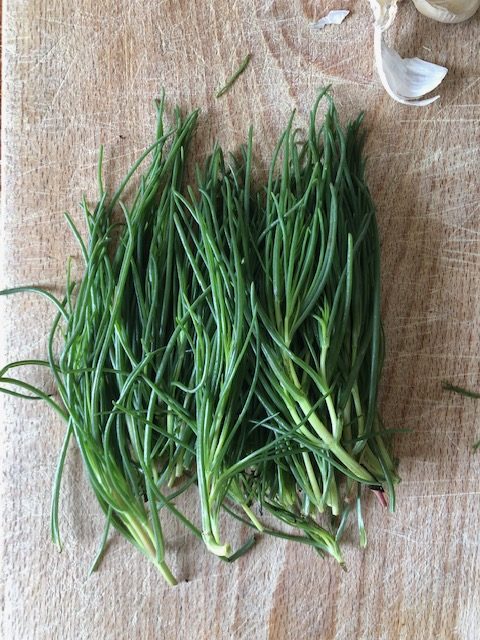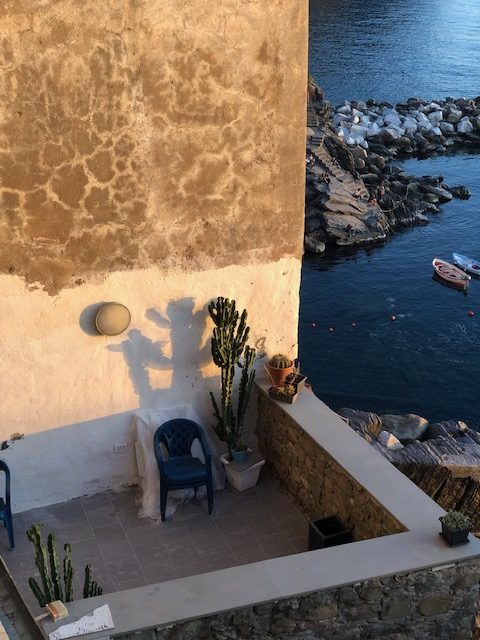

You know that sinking feeling you get when a tv series that you have been glued to ends and you’re just not ready to say goodbye? When that sentiment strikes, I find myself googling for more info, a pitch of sorts, to keep what we “have going” alive – filming location, the story’s inspo, and my particular favourite – the cast bios …
Well, a similar condition struck when I was introduced to the Italian veg agretti. After finishing a delicious meal, I wasn’t ready to say goodbye and a google search followed. What I found out in the plant’s “bio” was a surprising nugget that kept the meal magic alive, and it delayed that sinking feeling that the agretti and I were parting.
A very short-seasoned spring veg, agretti (in Italian, ‘little sour ones”) are also known as barba di frate or monk’s beard in English. It’s botanical name, salsola soda tells of another, unexpected story. You see agretti, were long cultivated to be burnt, their cinders producing a valuable source of soda ash, one of the alkali substances used in glass and soap making. Indeed, this humble, chive looking veg was grown for centuries for example, throughout Venice’s lagoon, to be used in the production of the famed Murano and Venice glass. In the past, massive quantities of agretti were gathered and burnt in Italy until a synthetic process was discovered in the 19thcentury. After that time, production focused on the veggie market.
Grown along the Mediterranean shoreline, agretti look like short, shiny, grassy weeds/fine emerald seaweed – super modest for such an impressive bio. The taste is complex – delicate and yet robust. Salty, green (yep, I kinda do think that food tastes like colours), somewhat mineraly, and kind of lemony. Frequently, the taste is likened to spinach and while in ways they are similar, they are also strikingly different. Spinach tastes of the earth, agretti, encapsulate the sea. Like eating a bowl of muscles, they transport you to the Med in moments.
The veg I grabbed yesterday and photographed here, have had their pink ends removed but typically, you need to snip them off yourself. Either way, give the leaves a super thorough rinse to remove any grit. When they are very young, agretti are often eaten raw in salad. Now in late spring, they are likely to be steamed, sauteed, eaten in soups, tossed in risotto, pasta, frittata, veg tarts, or on top of eggs.
I like to load them into a pan with garlic, chilli, some oil packed anchovies, together with a slosh of white wine. Softened gently then swished together with threads of spaghetti, they are super good. Many recipes also add pancetta, olives, capers and tomatoes – always a yumm addition, but to my mind, overshadowing the specialness of the agretti. If I have the energy, I make some crispy garlicy, breadcrumbs to sprinkle over the top of the cooked pasta, but if I want the whole thing to be ready in less time than the pasta cooks, I skip this bit and just add some grated lemon zest for a little zing.
*Note, we were out all of spaghetti, so I subbed here with a thicker fettuccine known as fettucce. Still, I’m calling the dish Spaghetti con Agretti. Firstly, because they are they are the classic pasta/sauce duo. And secondly, because it just sounds so lovely – Spaghetti con Agretti (Italian is *all* about the sound … Spaghetti con Fettucce .. nope).
See what you think … myself and agretti are never gunna say goodbye.


Spaghetti con Agretti ~ Spaghetti with Monk’s Beard
Serves 4
- 2/3 slices of stale sourdough bread, torn into pieces
- 1 garlic clove, peeled
- 3 tablespoons, parsley leaves, washed
- 40ml olive oil
- bunch of agretti, monk’s beard (about 300g with tips removed)
- 80ml olive oil
- 3 garlic cloves, minced
- sprinkle of chilli flakes
- 4 anchovies packed in oil
- 150ml white wine
- 320g pasta
- lemon zest
- salt and pepper
To make the crispy breadcrumbs: place the bread, garlic and parsley in a small food processor and whizz to form coarse breadcrumbs (some chunky bits are fine). Heat the olive oil in a frying pan over high heat and fry the breadcrumb mixture, stirring often until golden and fragrant. Set aside.
Over a high heat, bring a large pan of water to the boil. Once boiling, add salt (1 teaspoon /litre water). Add the pasta and cook until al dente.
Clean the agretti thoroughly by washing in a large bowl of water and drain well. Remove any exhausted looking strands and cut off the pink roots.
In a large frypan, heat the olive oil over a low-medium flame. Add the garlic, chilli flakes, anchovies, and a pinch of salt and pepper. Cook until the garlic is golden, and the anchovies are beginning to dissolve (keep nudging them around in the pan to prevent them from browning too quickly).
Add the agretti to the pan folding it over gently in the garlicy oil (like spinach the agretti will shrink and become. easier to stir). Add the wine and gently stir again. Cook for around 5 minutes or until the chunkiest bits of the agretti stems have softened.
Drain the pasta, reserving about ½ cup of the cooking water. Add the pasta to the agretti and toss everything to combine. Add a little of the preserved pasta water if the spaghetti seems at all dry.
Serve immediately, topping each plate with a drizzle of oil, some crispy breadcrumbs, salt, pepper, and a little lemon zest.

